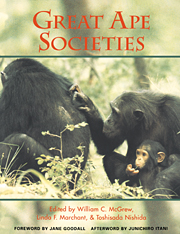Book contents
- Frontmatter
- Contents
- List of contributors
- Preface
- Foreword: conserving great apes
- Part I Apes overviewed
- Part II Social ecology
- 4 Social ecology of Kanyawara chimpanzees: implications for understanding the costs of great ape groups
- 5 Ranging and social structure of lowland gorillas in the Lopé Reserve, Gabon
- 6 Sympatric chimpanzees and gorillas in the Ndoki Forest, Congo
- 7 Dietary and ranging overlap in sympatric gorillas and chimpanzees in Kahuzi-Biega National Park, Zaïre
- Part III Social relations
- Part IV Minds
- Part V Apes compared
- Part VI Modeling ourselves
- Afterword: a new milestone in great ape research
- Appendix: great ape study sites
- Index
7 - Dietary and ranging overlap in sympatric gorillas and chimpanzees in Kahuzi-Biega National Park, Zaïre
Published online by Cambridge University Press: 04 August 2010
- Frontmatter
- Contents
- List of contributors
- Preface
- Foreword: conserving great apes
- Part I Apes overviewed
- Part II Social ecology
- 4 Social ecology of Kanyawara chimpanzees: implications for understanding the costs of great ape groups
- 5 Ranging and social structure of lowland gorillas in the Lopé Reserve, Gabon
- 6 Sympatric chimpanzees and gorillas in the Ndoki Forest, Congo
- 7 Dietary and ranging overlap in sympatric gorillas and chimpanzees in Kahuzi-Biega National Park, Zaïre
- Part III Social relations
- Part IV Minds
- Part V Apes compared
- Part VI Modeling ourselves
- Afterword: a new milestone in great ape research
- Appendix: great ape study sites
- Index
Summary
INTRODUCTION
Most primates that live in tropical forests form sympatric populations with other primate species. In some cases they avoid contact or interact aggressively with other primate species, while in other cases they forage, groom, play or mate with others, forming mixed-species groups (Struhsaker, 1978; Gautier-Hion, 1980; Terborgh, 1983). Since these interactions between species are difficult to see in the wild, details of interference competition among sympatric primates are sketchy. However, at least ecological (exploitation) competition can be estimated when two sympatric species show similarities in resource use (Waser, 1987).
Gorillas and chimpanzees live sympatrically and with other primate species in wide areas of Equatorial Africa. Both apes use all strata of the tropical forest and range in various types of vegetation. Unlike Cercopithecus, Cercocebus or Colobus monkeys, these apes do not form mixed-species groups. Because of their larger body size, both apes may dominate the other primate species and be able to exclude them from food resources, even when niche overlap occurs extensively with them. Chimpanzees usually chase monkeys at aggressive encounters and occasionally prey on them (McGrew et al., 1979; Nishida et al., 1983; Goodall, 1986; Sugiyama & Koman, 1987; Boesch & Boesch, 1989), although some arboreal monkeys (such as Colobus badius) may aggressively mob and displace chimpanzees (Struhsaker, 1981; Ghiglieri, 1984). Gorillas and chimpanzees are genetically close and show similarities in morphological features such as craniodental form (Sarich & Cronin, 1977; Shea, 1983), yet they show remarkable differences in ecological features and social organization.
- Type
- Chapter
- Information
- Great Ape Societies , pp. 82 - 98Publisher: Cambridge University PressPrint publication year: 1996
- 78
- Cited by



